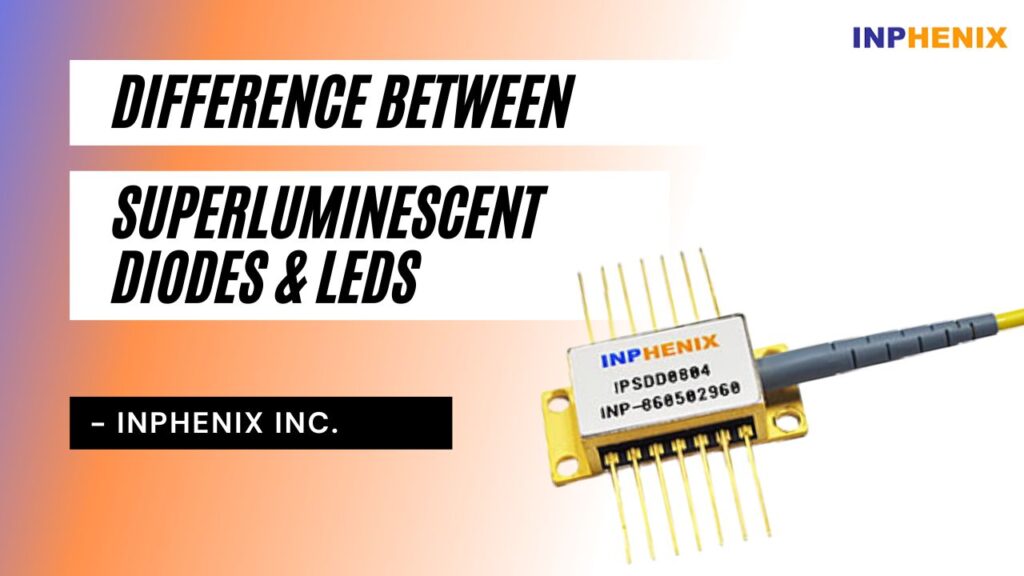
Optoelectronics has two major players SLDs and LEDs. They take centre stage, each boasting distinct characteristics and applications. Despite their shared function of emitting light, these devices differ significantly in terms of technology, performance, and utility.
This blog delves into the differences between superluminescent diodes and light-emitting diodes, offering insights into their unique features and diverse applications. Let’s learn and discover the specific roles these devices play in various technological landscapes.

Superluminescent diodes are sophisticated semiconductor devices that blend features of semiconductor lasers and light-emitting diodes. Specifically engineered to emit broad-spectrum light with high coherence, SLDs are ideal for applications that demand both spectral width and coherence as crucial factors.
SLDs generate light over a broad spectrum, unlike traditional laser diodes that emit light at discrete wavelengths. This broad spectral emission is a key feature that distinguishes superluminescent diodes from standard laser diodes.
Unlike lasers, SLDs exhibit low coherence, which means that the emitted light does not have a fixed phase relationship. This property is advantageous in applications such as optical coherence tomography (OCT) and fiber optic gyroscopes.
SLDs find applications in diverse fields, including medical imaging, spectroscopy, OCT, and fiber optic gyroscopes. Their ability to provide broad-spectrum, low-coherence light makes them valuable in applications where detailed imaging and precise measurements are crucial.
SLDs stand out for their high-performance precision, providing superior optical coherence for applications demanding accuracy and reliability. Because it is engineered to deliver precise and consistent output, ensuring optimal performance in various optical systems.
The commitment to innovation extends to creating tailored solutions for diverse applications. Whether in OCT, medical imaging, or spectroscopy, SLDs are designed to meet the specific requirements of each application. This versatility makes SLDs a preferred choice for industries requiring precision in their optical and photonic systems.
SLDs remain at the forefront of technological advancements, incorporating cutting-edge technology. This commitment to staying ahead of the curve ensures that users benefit from the latest innovations, enjoying enhanced capabilities and improved performance in their optical solutions.
In addition to precision and technological advancements, a strong emphasis is placed on the reliability and longevity of superluminescent diodes. The robust design, coupled with quality materials, ensures that these diodes have an extended lifespan, reducing the need for frequent replacements and maintenance.
Also Read: Properties, Features and Working of Superluminescent Diode
LEDs typically emit light in a narrow spectral band, while SLDs produce a broader spectrum. This difference in spectral characteristics influences the applications each device is suitable for. LEDs are often favored for applications where specific colors are required, such as display technologies and indicator lights.
LEDs exhibit low coherence similar to SLDs. However, the coherence properties of LEDs are not as precisely controlled as those of SLDs. The diode with their engineered low coherence, is better suited for applications demanding controlled coherence, such as in medical imaging.
LEDs are widely used in everyday applications, including lighting, displays, indicators, and automotive lighting. Their versatility and energy efficiency make them suitable for various consumer and industrial applications. On the other hand, SLDs excel in specialized fields like medical diagnostics, where their unique combination of broad-spectrum emission and low coherence is advantageous.
LEDs are generally more cost-effective and energy-efficient compared to SLDs. The widespread use of LEDs in general lighting and consumer electronics has driven significant advancements in their production efficiency, contributing to their affordability.
In summary, superluminescent diodes and light-emitting diodes are distinct light-emitting devices, each catering to specific applications based on their unique characteristics. While LEDs dominate everyday lighting and display technologies, SLDs find their niche in specialized fields where precise spectral characteristics and low coherence are paramount.
As technology advances, the boundaries between these devices may continue to blur, leading to innovations that harness the strengths of both SLDs and LEDs in various applications. Whether illuminating our daily surroundings or enabling cutting-edge medical diagnostics, these devices contribute significantly to the evolving landscape of optoelectronics.
